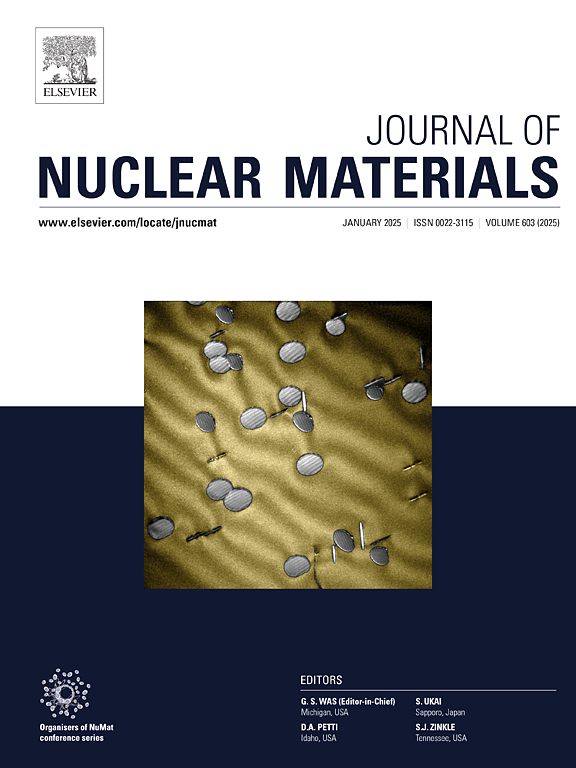氢在IPHWR的压力管中比氘更容易被吸收吗?
IF 2.8
2区 工程技术
Q3 MATERIALS SCIENCE, MULTIDISCIPLINARY
引用次数: 0
摘要
氢脆是锆基印度压重水堆压力管材料的主要寿命限制因素之一。作为这些压力管材料寿命管理的一部分,在反应堆关闭条件下从压力管中进行切片。分析了这些样品的氢(H)和氘(D)含量。在对这些样品的分析过程中,我们观察到H含量始终高于D含量,尽管初始H含量保持在5 ppmw以下,并使用核级D2O (D同位素纯度≥98.6%)作为冷却剂和加压刮刀。根据公认的吸氢机制,由于金属和金属氧化物界面H+/D+的还原而产生的新生氢/氘部分被结构材料吸收。因此,为了了解氢同位素的优先拾取,采用合适的电解质和不同量的H &对Zr-2.5%Nb合金试样进行电解;D.在带电标本中,H &;采用HVE-QMS技术测定D含量。与氘相比,Zr-2.5%Nb合金在H2O的所有摩尔分数中都优先吸收氢5-9倍;研究溶液中的D2O。为了研究吸附对Zr-2.5%Nb合金同位素偏好的影响,将Zr-2.5%Nb合金样品在633 K下暴露于不同成分的H2和D2气体中。氢比氘具有2-3倍的吸附优先性,其组成与吸附优先性无相关性。因此,综上所述,电解质质子/氘核交换反应、它们的还原(溶剂化能差)和吸附可能是观察到的优先性的原因。本文章由计算机程序翻译,如有差异,请以英文原文为准。
Is hydrogen preferentially picked- up in IPHWR's pressure tubes over deuterium?
Hydrogen embrittlement is one of the major life limiting factors for zirconium-based Indian pressurized heavy water reactor (IPHWR) pressure tube materials. As part of the lifetime management of these pressure tube materials, slivering from the pressure tubes is performed during reactor shutdown condition. These samples were analyzed for hydrogen (H) and deuterium (D) content. During the analysis of these samples, it was observed that the H content is always higher than the D content, although the initial H content is maintained less than 5 ppmw and nuclear grade D2O (D isotopic purity≥98.6%) is used as a coolant and also used to pressurize the scraping tool. According to the well-accepted mechanism for hydrogen pick-up, the nascent hydrogen/deuterium generated due to the reduction of H+/D+ at the metal and metal oxide interface is partially absorbed by the structural materials. Therefore, to understand the preferential pick-up of hydrogen isotope, Zr-2.5%Nb alloy specimens were electrolytically charged using a suitable electrolyte with a different amount of H & D. In the charged specimens, H & D contents were determined employing HVE-QMS technique. The hydrogen was preferentially absorbed by the Zr-2.5%Nb alloy between 5-9 times compared to deuterium for all mole fractions of H2O & D2O in the solution under study. To investigate the effect of adsorption on isotopic preferentiality, Zr-2.5%Nb alloy samples were exposed to different compositions of H2 and D2 gases at 633 K. Hydrogen has 2-3 time preferentiality over deuterium for adsorption and no correlation of the composition with the preferentiality was found. Therefore, in summary, the electrolyte proton/deuteron exchange reaction, their reduction (solvation energy difference), and adsorption may be responsible for the observed preferentiality.
求助全文
通过发布文献求助,成功后即可免费获取论文全文。
去求助
来源期刊

Journal of Nuclear Materials
工程技术-材料科学:综合
CiteScore
5.70
自引率
25.80%
发文量
601
审稿时长
63 days
期刊介绍:
The Journal of Nuclear Materials publishes high quality papers in materials research for nuclear applications, primarily fission reactors, fusion reactors, and similar environments including radiation areas of charged particle accelerators. Both original research and critical review papers covering experimental, theoretical, and computational aspects of either fundamental or applied nature are welcome.
The breadth of the field is such that a wide range of processes and properties in the field of materials science and engineering is of interest to the readership, spanning atom-scale processes, microstructures, thermodynamics, mechanical properties, physical properties, and corrosion, for example.
Topics covered by JNM
Fission reactor materials, including fuels, cladding, core structures, pressure vessels, coolant interactions with materials, moderator and control components, fission product behavior.
Materials aspects of the entire fuel cycle.
Materials aspects of the actinides and their compounds.
Performance of nuclear waste materials; materials aspects of the immobilization of wastes.
Fusion reactor materials, including first walls, blankets, insulators and magnets.
Neutron and charged particle radiation effects in materials, including defects, transmutations, microstructures, phase changes and macroscopic properties.
Interaction of plasmas, ion beams, electron beams and electromagnetic radiation with materials relevant to nuclear systems.
 求助内容:
求助内容: 应助结果提醒方式:
应助结果提醒方式:


